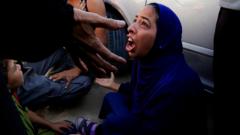At least 20 individuals tragically lost their lives due to a crush at an aid distribution center in Khan Younis, southern Gaza, managed by the US- and Israel-supported Gaza Humanitarian Foundation (GHF). According to the GHF and local hospital reports, 19 were trampled to death, while one individual was reportedly stabbed amidst a "chaotic and dangerous surge" at the facility. The GHF alleged that individuals "armed and affiliated with Hamas" instigated the unrest, a claim vehemently denied by Hamas' Government Media Office, which accused the GHF of attempting to "cover up" the situation's true causes.
The Nasser Hospital in Khan Younis confirmed that it received the bodies of 21 victims, who suffered from suffocation due to tear gas inhalation and the crowd crush at the aid site. This incident marks the first time the GHF has confirmed fatalities at one of its distribution centers. Disturbing footage circulating on social media, verified by the BBC, depicted a scene in which a witness described the grim aftermath, observing victims crushed against fences while waiting for food supplies. "They are children. What is it their fault dying for aid?" the eyewitness cried out, showcasing the dire consequences of the chaos that ensued.
Eyewitness accounts detail how increasing pressure from the crowd, along with contractors attempting to control the gates, contributed to the tragic incident. Witness Mahmoud Fojo recounted the growing tension as contractors began closing the entrance gates, leading to overwhelming pressure from the waiting individuals. "Those who couldn't stand fell under the people and were crushed," he relayed.
Further allegations emerged, accusing armed contractors of having clashed with the crowd and igniting tensions, allegedly deploying tear gas and pepper bombs. However, the GHF spokesperson refuted these claims, stating that tear gas was never used and asserting that minimal pepper spray was only utilized to prevent greater loss of life. GHF’s spokesperson Chapin Fay indicated the incident was "instigated by armed Hamas operatives" that manipulated the crowd's chaos resulting in the loss of lives.
The GHF utilizes private security to facilitate aid distribution in Israeli military-designated zones, defending this approach as necessary to prevent Hamas from hijacking the aid. Nonetheless, the United Nations has expressed its disapproval, labeling the GHF's operational model as unethical. Reports have surfaced almost daily regarding fatalities among those seeking assistance since the GHF’s inception of operations in late May. Many victims have reportedly been shot by Israeli forces, a grim reality coupled with the UN's record of escalating deaths near GHF distribution points.
Thameen Al-Kheetan from the UN human rights office highlighted the serious humanitarian crisis in Gaza, where hundreds of thousands are left desperate amid limited access to assistance. He called for Israel, as the occupying force, to ensure unimpeded humanitarian access in accordance with the dire needs of the civilian population. Prior to the recent tragedy, the GHF had consistently denied any fatalities near their sites, challenging figures released by the Hamas-run local health ministry, while the Israeli military acknowledged having recognized incidents causing civilian harm.
The Nasser Hospital in Khan Younis confirmed that it received the bodies of 21 victims, who suffered from suffocation due to tear gas inhalation and the crowd crush at the aid site. This incident marks the first time the GHF has confirmed fatalities at one of its distribution centers. Disturbing footage circulating on social media, verified by the BBC, depicted a scene in which a witness described the grim aftermath, observing victims crushed against fences while waiting for food supplies. "They are children. What is it their fault dying for aid?" the eyewitness cried out, showcasing the dire consequences of the chaos that ensued.
Eyewitness accounts detail how increasing pressure from the crowd, along with contractors attempting to control the gates, contributed to the tragic incident. Witness Mahmoud Fojo recounted the growing tension as contractors began closing the entrance gates, leading to overwhelming pressure from the waiting individuals. "Those who couldn't stand fell under the people and were crushed," he relayed.
Further allegations emerged, accusing armed contractors of having clashed with the crowd and igniting tensions, allegedly deploying tear gas and pepper bombs. However, the GHF spokesperson refuted these claims, stating that tear gas was never used and asserting that minimal pepper spray was only utilized to prevent greater loss of life. GHF’s spokesperson Chapin Fay indicated the incident was "instigated by armed Hamas operatives" that manipulated the crowd's chaos resulting in the loss of lives.
The GHF utilizes private security to facilitate aid distribution in Israeli military-designated zones, defending this approach as necessary to prevent Hamas from hijacking the aid. Nonetheless, the United Nations has expressed its disapproval, labeling the GHF's operational model as unethical. Reports have surfaced almost daily regarding fatalities among those seeking assistance since the GHF’s inception of operations in late May. Many victims have reportedly been shot by Israeli forces, a grim reality coupled with the UN's record of escalating deaths near GHF distribution points.
Thameen Al-Kheetan from the UN human rights office highlighted the serious humanitarian crisis in Gaza, where hundreds of thousands are left desperate amid limited access to assistance. He called for Israel, as the occupying force, to ensure unimpeded humanitarian access in accordance with the dire needs of the civilian population. Prior to the recent tragedy, the GHF had consistently denied any fatalities near their sites, challenging figures released by the Hamas-run local health ministry, while the Israeli military acknowledged having recognized incidents causing civilian harm.



















